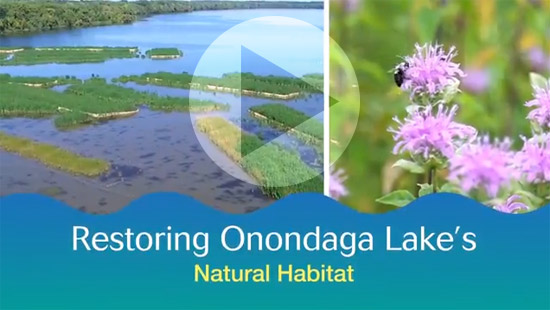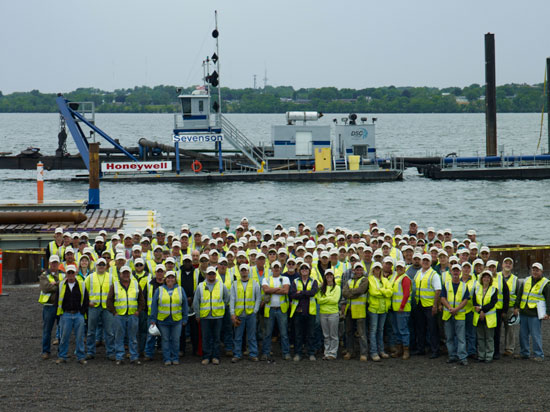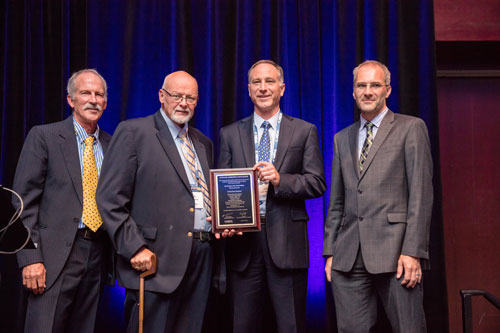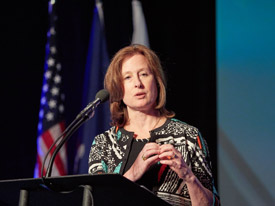Eighth-Graders Participate in Weeklong Investigation of Onondaga Lake Watershed
More than 70 middle school students conducted scientific experiments, investigated the Onondaga Lake watershed, and learned about the impact of the Onondaga Lake cleanup during Honeywell Summer Science Week. Now celebrating its 12th year, Honeywell Summer Science Week, which is organized by the Milton J. Rubenstein Museum of Science & Technology (MOST), has inspired nearly 700 students through hands-on science exploration.
“It was heartwarming to see my son literally grow and thrive on the opportunity to get out to hunt for fossils, investigate the watershed, and tour the ecosystems surrounding the lake,” said Craig Lazzar, a parent. “He came home excited about what he learned every day.”
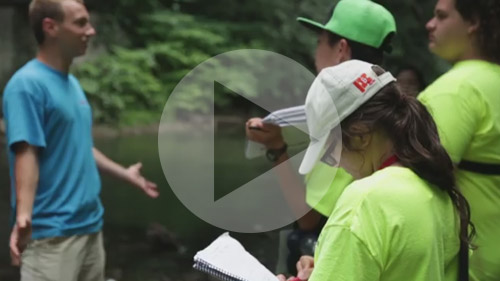
Watch a video about the impact of Honeywell Summer Science Week.

During Honeywell Summer Science Week, students spend more than 40 hours as field scientists.
Left: An environmental engineer leads a Z-Boat demonstration. A Z-Boat uses GPS and sonar to monitor the Onondaga Lake cap. The cap, which was placed on 475 acres of the lake bottom, provides a new habitat layer. The cap consists primarily of sand, carbon, and stone.
Right: Emily Quinn, of the West Genesee Central School District, examines a fish caught in Onondaga Lake.
Honeywell Summer Science Week brings science to life as students become field researchers learning from scientists, engineers, professors, and college students about the watershed and associated environmental sciences. The program motivates students by improving their science aptitude and confidence, and encourages them to work toward careers in science, technology, engineering, and math (STEM).
“This is an outstanding program that involves students who are about to enter high school, when many will have their first science lab class,” said MOST President Toni Martin. “Having this experience conducting science experiments gives them the confidence they need for greater academic achievement.”
Students investigate Onondaga Lake water quality and learn from habitat experts and engineers about the cleanup at Honeywell’s Onondaga Lake Visitors Center.

Left: Mikeila Bennett, of the Solvay Union Free School District, uses a pH strip to test the water quality of Onondaga Lake.
Right: Onondaga Lake Conservation Corps Coordinator Sue Potrikus (center) teaches students Allison DeJoy (left), of the West Genesee Central School District, and Amina Salahou, of the Syracuse City School District, about the cleanup.

2017 Honeywell Summer Science Week participants.
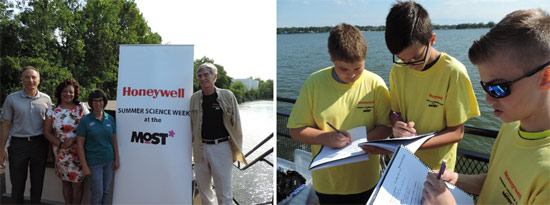
On July 10, Honeywell and the MOST joined students aboard the Emita II tour boat to kick off Honeywell Summer Science Week.
Left: (Pictured left to right) Honeywell Syracuse Program Director John McAuliffe, New York State Assembly Member Pamela Hunter, MOST President Toni Martin, and MOST Chief Program Officer Peter Plumley.
Right: Honeywell Summer Science Week students (left to right) Zachary Voss, Preston Vella, and Tyler Meier, of the West Genesee Central School District, track bird species aboard the Emita II.
Throughout the week, students participated in a variety of activities while learning an interdisciplinary approach to investigation, discovery, and resolution of environmental issues facing Onondaga County. Field activities included collecting water samples throughout the Tully Valley and the Onondaga Lake watershed, touring Onondaga Lake, and exploring Clark Reservation, Onondaga Creek, and Nine Mile Creek. Students also learned about fish in the lake, underwater mapping, and the engineering behind the lake bottom cap.
“Honeywell Summer Science Week puts our students out in the field every day to conduct hands-on investigations,” said MOST Chief Program Officer Peter Plumley, Ph.D. “The program introduces them to scientific methodology and observation of the natural world. Many program graduates go on to successfully compete in the Central New York Science & Engineering Fair and win college scholarships.”
“Honeywell Summer Science Week has inspired students through engaging experiments and innovative programming for the past 12 years,” said Honeywell Syracuse Program Director John McAuliffe. “The students are preparing to become the next generation of scientists and engineers in Central New York. The lessons help them become more confident in science and math and provide an interdisciplinary approach to resolving complex environmental issues.”
Honeywell Discovery Day
The students reunited one last time on July 19, during Honeywell Discovery Day, to discuss their scientific findings.

Left: Students present their observations to Honeywell Syracuse Program Director John McAuliffe.
Right: Honeywell Summer Science Week students receive completion certificates and become “MOST Associates,” which grants each student a one-year museum pass.
Local companies, organizations, and individuals participating include: Montezuma Audubon Center, U.S. Geological Survey, OBG, Parsons, Anchor QEA, Onondaga County Department of Water Environment Protection, and faculty and graduate students from Syracuse University and State University of New York College of Environmental Science and Forestry. The program exposes students, who are about to enter high school, to real scientists and university professors, preparing them for future studies and possible STEM careers.
Honeywell Summer Science Week is sponsored by Honeywell Hometown Solutions, the company’s corporate citizenship initiative that focuses on five areas of vital importance: Science & Math Education, Family Safety & Security, Housing & Shelter, Habitat & Conservation, and Humanitarian Relief. Together with leading public and non-profit institutions, Honeywell has developed powerful programs to address these needs in the communities it serves. For more information, please visit http://citizenship.honeywell.com/hometown-solutions.
For more information on the Onondaga Lake cleanup, please visit www.lakecleanup.com.


